
The Charge of the Light Brigade is a 1936 American historical adventure film from Warner Bros., starring Errol Flynn and Olivia de Havilland. It was directed by Michael Curtiz and produced by Samuel Bischoff, with Hal B. Wallis as the executive producer. The film's screenplay is by Michael Jacoby and Rowland Leigh, from a story by Michael Jacoby, and based on the 1854 poem "The Charge of the Light Brigade" by Alfred, Lord Tennyson. The music score was composed by Max Steiner, his first for Warner Bros., and the cinematography was by Sol Polito. Scenes were shot at the following California locations: Lone Pine, Sherwood Lake, Lasky Mesa, Chatsworth, and Sonora. The Sierra Nevada mountains were used for the Khyber Pass scenes.

Gentleman Jim is a 1942 film directed by Raoul Walsh and starring Errol Flynn as heavyweight boxing champion James J. Corbett (1866–1933). The supporting cast includes Alexis Smith, Jack Carson, Alan Hale, William Frawley, and Ward Bond as John L. Sullivan. The movie was based upon Corbett's 1894 autobiography, The Roar of the Crowd. The role was one of Flynn's favorites.

The film appearances of movie actor Errol Flynn (1909–1959) are listed here, including his short films and one unfinished feature.

That Forsyte Woman is a 1949 American romantic drama film directed by Compton Bennett and starring Greer Garson, Errol Flynn, Walter Pidgeon, Robert Young and Janet Leigh. It is an adaptation of the 1906 novel The Man of Property, the first book in The Forsyte Saga by John Galsworthy.
Seton Ingersoll Miller was an American screenwriter and producer. During his career, he worked with film directors such as Howard Hawks and Michael Curtiz. Miller received two Oscar nominations and won once for Best Screenplay for the 1941 fantasy romantic comedy film, Here Comes Mr. Jordan, along with Sidney Buchman.
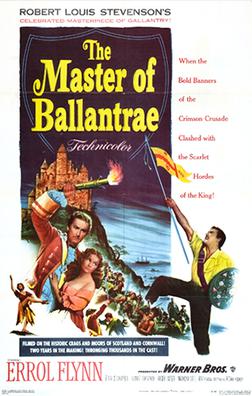
The Master of Ballantrae is a 1953 British Technicolor adventure film starring Errol Flynn and Roger Livesey. It is a loose and highly truncated adaptation of the Robert Louis Stevenson 1889 novel of the same name. In eighteenth century Scotland, two sons of a laird clash over the family estate and a lady. It was the last film directed by William Keighley.

The Case of the Curious Bride is a 1935 American mystery film, the second in a series of four starring Warren William as Perry Mason, following The Case of the Howling Dog. The script was based on the 1934 novel of the same name by Erle Stanley Gardner, published by William Morrow and Company, which proved to be one of the most popular of all the Perry Mason novels.

Footsteps in the Dark is a 1941 American comedy mystery film directed by Lloyd Bacon and starring Errol Flynn, Brenda Marshall and Ralph Bellamy. It was produced and distributed by Warner Brothers. Flynn plays a novelist and amateur detective investigating a murder. It takes its title from the 1935 play Footsteps in the Dark by Ladislas Fodor and also used material from the 1937 play Blondie White by Jeffrey Dell.

Never Say Goodbye is a 1946 American romantic comedy film directed by James V. Kern and starring Errol Flynn, Eleanor Parker, and Lucile Watson. Produced and distributed by Warner Brothers, it is about a divorced couple and the daughter who works to bring them back together. It was Errol Flynn's first purely comedic role since Footsteps in the Dark.

Cry Wolf is a 1947 American mystery film noir directed by Peter Godfrey and starring Errol Flynn, Barbara Stanwyck and Geraldine Brooks. It was produced and distributed by Warner Bros. It is based on the 1945 novel of the same name by Marjorie Carleton.
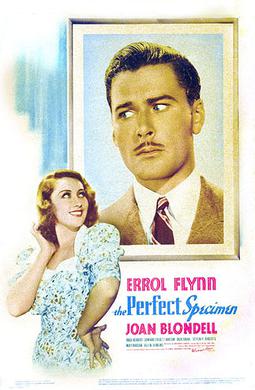
The Perfect Specimen is a 1937 American romantic comedy film directed by Michael Curtiz and starring Errol Flynn and Joan Blondell. The picture is based on a novel by Samuel Hopkins Adams.
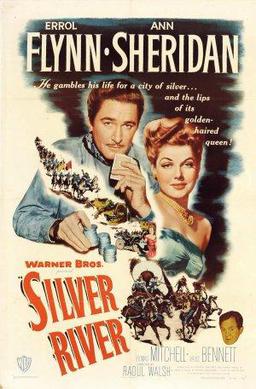
Silver River is a 1948 American western film directed by Raoul Walsh and starring Errol Flynn, Ann Sheridan and Thomas Mitchell. The film is based on a Stephen Longstreet story that was turned into a novel. It was produced and distributed by Warner Bros.

Lydia Bailey is a 1952 American historical adventure film directed by Jean Negulesco and starring Dale Robertson, Anne Francis and Charles Korvin. It was made by 20th Century Fox and based on the 1947 novel of the same name by Kenneth Roberts.
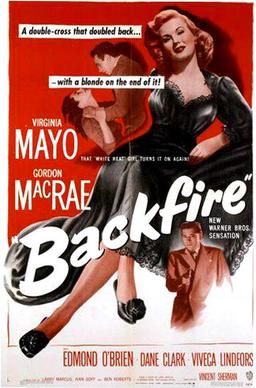
Backfire is a 1950 American film noir crime film directed by Vincent Sherman starring Virginia Mayo and Gordon MacRae, with Edmond O'Brien, Dane Clark, and Viveca Lindfors in support.

Adventures of Captain Fabian or Adventure in New Orleans is a 1951 American adventure film directed by William Marshall and starring Errol Flynn, Micheline Presle, Vincent Price, Agnes Moorehead and Victor Francen.
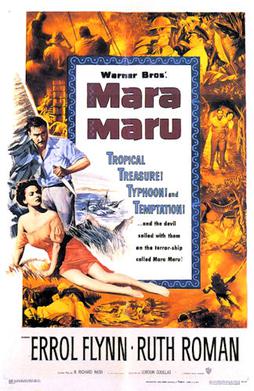
Mara Maru is a 1952 American noir action film starring Errol Flynn, Ruth Roman and Raymond Burr. Directed by Gordon Douglas, it was the last movie Flynn made for Warner Bros where he had started out in Hollywood in 1935.

Montana is a 1950 American Western film directed by Ray Enright and starring Errol Flynn. It was only the second time Flynn played an Australian on screen, the first time being Desperate Journey (1942).
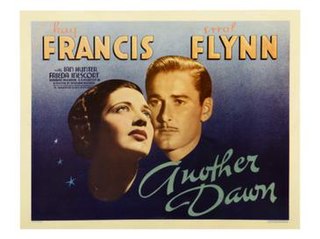
Another Dawn is a 1937 American melodrama film directed by William Dieterle and starring Errol Flynn, Kay Francis and Ian Hunter. It is based on Somerset Maugham's 1919 play Caesar's Wife. It was produced and distributed by Warner Brothers. The film received dismissive reviews.

Crossed Swords or The Teacher of Don Juan is a 1954 historical swashbuckling adventure film directed by Milton Krims and starring Errol Flynn, Gina Lollobrigida and Nadia Gray. It was co-production between Italy and the United States. It was shot at the Cinecittà Studios in Rome. The film's sets were designed by the art director Arrigo Equini.

Last of the Buccaneers is a 1950 American Technicolor adventure film directed by Lew Landers and starring Paul Henreid as Jean Lafitte.



















